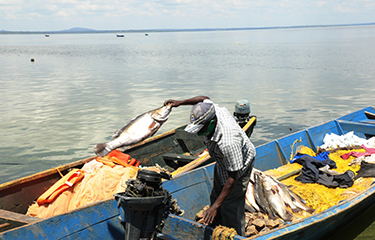Kenya's earnings from seafood exports increased by more than 60 percent in 2022.
Two reports released in May 2023 by the country's National Bureau of Statistics (KNBS) and the Central Bank of Kenya (CBK) indicate the country's export earnings jumped to KES 5.6 billion (USD 40.5 million, EUR 37.5 million) in 2022 compared to KES 3.4 billion (USD 24.6 million, EUR 22.7 million) in 2022 as market prices appreciated. The per-kilo average price attained increased to KES 412 (USD 3.00, EUR 2.80) from KES 316 (USD 2.30, EUR 2.10) in 2021.
Kenya's export volumes of fish and fish products for 2022 also increased by more than 25 percent, reaching 13,624 metric tons (MT), up from 10,875 MT in 2021.
The increase was mainly due to a reported surge in fish landings on the back of more government investments in infrastructure at several inland and marine fishery sites, as well as an uptick in aquaculture production.
The Kenya Fisheries Service (KeFS) – a government agency that conserves, manages, and develops the country's fisheries and aquaculture resources – attributed the spike in landings to several factors, including infrastructure upgrades around Lake Victoria, the biggest source of freshwater fish in Africa. Kenya's government has fast-tracked the construction of fish-processing facilities in the cities of Lamu and Mombasa.
Additionally, The recent replacement of the Mbita causeway on Lake Victoria with a fly-over bridge has substantially improved water flushing in the lake’s bays. The replacement has also opened up a route for fish that had previously been inaccessible due to the causeway, freeing more fish to move throughout the lake.
KeFS Head of Statistics Stephen Ndegwa also lauded the success of improved data collection and transparency efforts.
“There has recently been an improvement in data collection as the government deployed additional personnel, hence capturing and processing more information on fish landings unlike the case previously,” Ndegwa said.
To further improve data collection in the country, Kenya’s Department of Fisheries, in partnership with the World Bank, has introduced the Kenya Marine Fisheries and Socio-Economic Development (KEMFSED) project. The project aims to establish “a fully functional fisheries information management system that integrates all data including catch totals and fishing effort, prices, licensing, permitting, research data, fisheries compliance, as well as mobile data application integration, statistical applications, and reporting.”
Lake Victoria’s fishery, shared by Tanzania (51 percent), Uganda (43 percent), and Kenya (6 percent) contributed 97,500 MT, or 69 percent, of the 141,400 MT of fish caught from Kenya’s inland fresh-water sources in 2022, reflecting a 3.4 percent increase from the 135,000 MT landed in 2021.
The increase came despite climate change and pollution affecting stocks in the world’s third-largest lake, though unfavorable weather conditions at Lake Tanganyika and Lake Nyasa did adversely impact Kenya's landings.
Kenya’s seafood industry is benefitting from an export-promotion program launched in 2022 by the Kenya TradeNet Network Agency in partnership with the Deutsche Gesellschaft für Internationale Zusammenarbeit (GIZ) through the German Alliance for Trade Facilitation (GAfTF), focusing on improving fish export procedures for ease of trade.
“The overall objective of the project is to map, simplify, and, where possible, digitize trade procedures for two commodities: avocado and fish. This is done in close cooperation with key government regulators and the private sector,” GafTF said.
In neighboring Tanzania, a report from the Bank of Tanzania indicated a decline in European demand pushed down the value of its seafood exports in 2022, as did adverse weather conditions, especially in southern Tanzania.
Photo courtesy of the World Meteorological Organization







